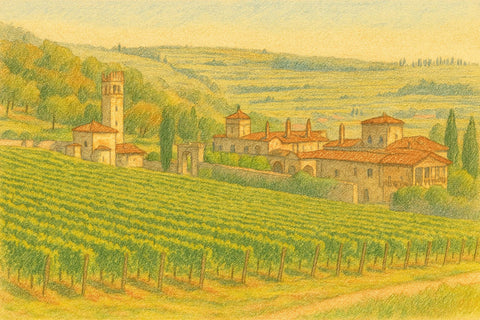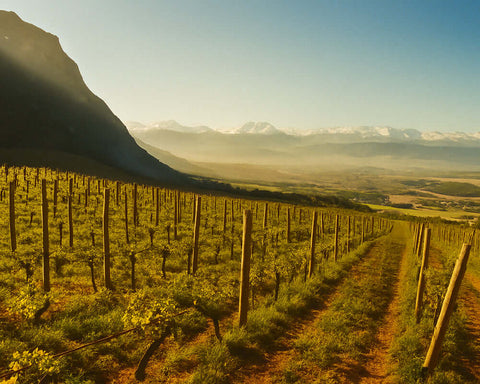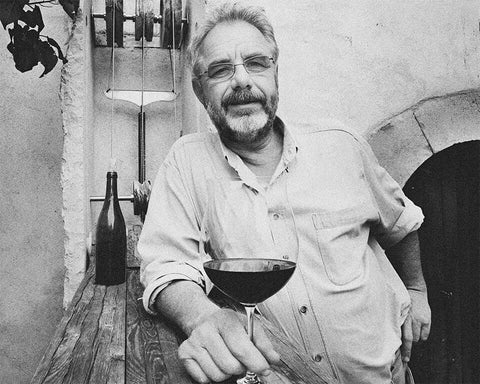Rías Baixas, located in northwestern Spain's Galicia region, has emerged as one of Europe's premier white wine regions, producing distinctive Albariño-based wines that have redefined Spanish white wine on the global stage. Bordered by the Atlantic Ocean to the west and Portugal to the south, this maritime region encompasses five subzones along dramatic estuaries where rivers meet the sea. The region's Atlantic climate, granite soils, and indigenous grape varieties create white wines known for their vibrant acidity, mineral character, and remarkable ability to pair with seafood.
Since achieving DO status in 1988, Rías Baixas has transformed from a region of local cooperatives into Spain's most successful white wine export story. The region's focus on Albariño, combined with sustainable viticulture practices adapted to the humid Atlantic climate, produces excellent wines.
Table of Contents
History of Rías Baixas
The viticultural history of Rías Baixas dates back to Roman times, though the region's modern identity began taking shape in the 12th century when Cistercian monks from Burgundy arrived via the Camino de Santiago. These monks recognized the potential of local grape varieties and established monasteries with vineyards, introducing systematic viticulture to the region.
Medieval records from the Monastery of Armenteira document extensive Albariño plantings by the 12th century. The variety's name possibly derives from "alba-riño" (white from the Rhine), suggesting either Germanic origins or comparison to Rhine wines. Local nobility and religious orders maintained vineyards throughout the Middle Ages, with wine production centered around monasteries and pazos (manor houses).
The 18th and 19th centuries saw increased commercialization, though most wine remained for local consumption. The phylloxera crisis of the 1880s devastated vineyards, leading to replanting with hybrid varieties and a decline in quality. This period also saw significant emigration to Latin America, creating future export markets when emigrants sought wines from their homeland.
The modern era began in the 1980s with pioneers like Pazo de Barrantes and Martín Códax, who invested in temperature-controlled fermentation and modern winemaking equipment. The establishment of the DO Rías Baixas in 1988 marked a turning point, setting quality standards and promoting Albariño internationally. The 1990s and 2000s saw explosive growth in exports, particularly to the United States and United Kingdom.
Today, Rías Baixas continues evolving, with producers experimenting with barrel fermentation, extended lees aging, and sustainable viticulture. The region has successfully positioned itself as Spain's premier white wine region, with Albariño achieving recognition as one of the world's great white varieties.
Terroir of Rías Baixas
Rías Baixas occupies a unique position in Spanish viticulture, with its Atlantic climate creating conditions more similar to Portugal's Vinho Verde or France's Muscadet than typical Spanish wine regions. The region covers approximately 4,000 hectares of vineyards spread across five subzones, each with distinct characteristics shaped by proximity to the ocean, river valleys, and elevation.
The Atlantic Ocean dominates the climate, bringing abundant rainfall (1,200-1,800mm annually) and moderate temperatures. Maritime influence prevents extreme heat in summer and frost in winter, creating a long, slow growing season ideal for preserving acidity in white grapes. The high humidity presents viticultural challenges, requiring careful canopy management and sustainable farming practices.
The Geology of Rías Baixas
The region's geology reflects its position on the ancient Iberian Massif, with predominantly granite-based soils that contribute to the wines' characteristic minerality.
- Granite (Xabre): Decomposed granite soils dominate, providing excellent drainage and contributing mineral notes to wines. The shallow topsoil forces vines to root deeply.
- Alluvial Deposits: River valleys contain alluvial soils with rounded stones, offering good drainage while retaining some moisture during dry periods.
- Schist: Found primarily in Ribeira do Ulla, these metamorphic soils produce wines with distinctive mineral complexity.
- Sandy Soils: Coastal areas feature sandy soils that warm quickly and provide excellent drainage, producing lighter, more aromatic wines.
This geological diversity allows different subzones to produce distinct expressions of Albariño, from the powerful wines of Val do Salnés to the more delicate styles of O Rosal.
Climate and its Influence
The Atlantic climate defines Rías Baixas viticulture. High rainfall necessitates the traditional pergola training system, elevating grapes away from ground moisture. The maritime influence moderates temperatures, with average annual temperatures around 14°C, creating conditions that preserve natural acidity while allowing full phenolic ripeness.
The Grapes of Rías Baixas
While Albariño dominates plantings and reputation, Rías Baixas permits twelve grape varieties, maintaining traditions while allowing innovation.
White Grape Varietals
- Albariño: Comprising 96% of plantings, this thick-skinned variety resists humidity while producing aromatic wines with stone fruit character and crisp acidity.
- Loureira: Aromatic variety adding floral notes and complexity to blends, particularly in O Rosal and Condado do Tea.
- Treixadura: Provides body and texture to blends, with apple and citrus characteristics.
- Caiño Blanco: Ancient local variety being revived, offering high acidity and mineral complexity.
Red Grape Varietals
- Mencía: Primary red variety producing light, aromatic wines with red fruit character.
- Caiño Tinto: Local variety known for high acidity and aging potential.
- Espadeiro: Traditional variety producing light, fresh reds.
- Sousón: Adds color and structure to red blends.
Top Wines of Rías Baixas
Classic Albariño: The region's signature wine, typically fermented in stainless steel to preserve freshness. These wines display peach, apricot, and citrus notes with distinctive minerality and saline character. Best examples come from old vines in Val do Salnés, showing concentration and complexity while maintaining vibrant acidity.
Barrel-Fermented Albariño: Premium producers increasingly use oak fermentation and lees aging to create more complex, age-worthy wines. These maintain Albariño's fruit character while adding texture and subtle vanilla notes. Extended lees contact adds complexity without masking varietal character.
Subzone Expressions: Each subzone produces distinct styles: Val do Salnés offers the most Atlantic-influenced wines with pronounced minerality; O Rosal permits blending with Loureira and Treixadura for added aromatics; Condado do Tea's inland location produces riper, more powerful wines; Soutomaior's small production shows unique character; Ribeira do Ulla's schist soils create distinctive mineral-driven wines.
Aged Albariño: Contrary to conventional wisdom, quality Albariño ages remarkably well. Premium examples develop honeyed notes and petrol-like aromas reminiscent of aged Riesling while maintaining fresh acidity. Producers increasingly release library vintages demonstrating Albariño's aging potential.
Red Wines: While representing less than 1% of production, red wines from indigenous varieties like Caiño Tinto and Mencía show promise. These light, Atlantic-influenced reds offer an alternative expression of Rías Baixas terroir.
Cuisine and Typical Products of Rías Baixas
Galician cuisine ranks among Spain's finest, built on exceptional seafood, high-quality meats, and produce from the region's fertile valleys. The cooking style emphasizes simplicity and product quality, with preparations designed to highlight rather than mask natural flavors. This philosophy perfectly complements Albariño's fresh, mineral character.
The Atlantic Ocean provides extraordinary seafood—percebes (gooseneck barnacles), oysters, mussels, octopus, and numerous fish species. The region's rivers yield salmon, trout, and lamprey, while the interior produces excellent beef, distinctive cheeses, and vegetables. Galicia's wet climate supports lush pastures and productive gardens, creating a natural abundance reflected in the cuisine.
Galician cooking traditions include unique preparations like pulpo á feira (octopus with paprika and olive oil), empanadas with various fillings, and caldos (broths) that warm against the Atlantic dampness. The region's Celtic heritage appears in certain dishes and the use of potatoes, while proximity to Portugal influences preparations in southern areas.
Galician Antipasti
Meals often begin with pristine seafood and simple preparations:
- Percebes: Gooseneck barnacles boiled in seawater, prized for their intense ocean flavor.
- Navajas: Razor clams grilled with garlic and parsley.
- Mejillones al Vapor: Steamed mussels from the rías, often with white wine.
- Pimientos de Padrón: Small green peppers fried in olive oil and sprinkled with coarse salt.
Galician First Courses
First courses showcase both sea and land:
- Caldo Gallego: Traditional broth with white beans, potatoes, turnip greens, and chorizo.
- Empanada Gallega: Savory pie with various fillings—tuna, cod, pork, or vegetables.
- Vieiras a la Gallega: Scallops baked with breadcrumbs, onion, and jamón.
- Sopa de Mariscos: Rich seafood soup with local shellfish and fish.
Galician Second Courses
Main courses celebrate the region's exceptional proteins:
- Pulpo á Feira: Boiled octopus with olive oil, paprika, and coarse salt—Galicia's most iconic dish.
- Merluza a la Gallega: Hake with potatoes, paprika, and garlic in olive oil.
- Lacón con Grelos: Pork shoulder with turnip greens, a winter classic.
- Caldeirada: Fisherman's stew with various fish, potatoes, and paprika.
Galician Side Dishes
Simple preparations highlight quality produce:
- Cachelos: Boiled potatoes dressed with olive oil and paprika.
- Grelos: Turnip greens sautéed with garlic.
- Ensalada de Tomate: Tomato salad with local tomatoes, onions, and olive oil.
Galician Cheeses
Galicia produces several distinctive cheeses:
- Tetilla: Cone-shaped cow's milk cheese with mild, creamy flavor.
- San Simón da Costa: Smoked cow's milk cheese with distinctive birchwood flavor.
- Arzúa-Ulloa: Soft cow's milk cheese with protected designation.
- Cebreiro: Fresh cheese traditionally made in the mountains.
Galician Desserts
Traditional sweets often feature almonds and local dairy:
- Tarta de Santiago: Almond cake marked with the Cross of Saint James.
- Filloas: Thin crepes filled with cream or served with honey.
- Orejas: Pastries shaped like ears, fried and dusted with sugar.
- Melindres: Small sponge cakes soaked in syrup.
Typical Products of Rías Baixas
The region's gastronomy relies on exceptional local products that reflect its maritime character and agricultural traditions.
Mejillones de Galicia
Galician mussels, cultivated on bateas (floating platforms) in the rías, represent 80% of Spain's mussel production. The nutrient-rich waters produce plump, flavorful mussels harvested year-round.
Percebes
Gooseneck barnacles, harvested from rocky shores at considerable risk, command premium prices. These prehistoric-looking crustaceans offer intense ocean flavor and pair perfectly with Albariño.
Grelos
Turnip greens, a Galician staple, appear in numerous traditional dishes. Harvested before flowering, they provide slightly bitter flavor and important nutrients during winter months.
Aguardiente de Orujo
Traditional grape pomace spirit, often herbs-infused, serves as digestif and features in the dramatic queimada ritual. Quality producers create refined versions rivaling Italian grappa.
More on Rías Baixas's History
- Celtic and Roman Roots
- Monastic Influence
- Maritime Connections
- Modern Revolution
- International Success
Celtic and Roman Roots
Celtic castro culture established early agricultural practices, while Roman occupation introduced systematic viticulture. Archaeological evidence shows wine production in the region dating to the 1st century CE.
Monastic Influence
Cistercian monks arriving in the 12th century recognized Albariño's potential, establishing vineyards and documenting cultivation practices that influenced the region for centuries.
Maritime Connections
Galicia's fishing fleet and maritime trade created early export markets, with wine supplied to ships and traded along Atlantic routes, establishing commercial traditions that continue today.
Modern Revolution
The 1980s transformation began with pioneers investing in modern winemaking technology, temperature control, and quality viticulture, elevating Albariño from local curiosity to internationally recognized variety.
International Success
Rías Baixas achieved remarkable international success in the 21st century, with exports growing exponentially and Albariño establishing itself as one of the world's premier seafood wines, transforming the region's economy and identity.










